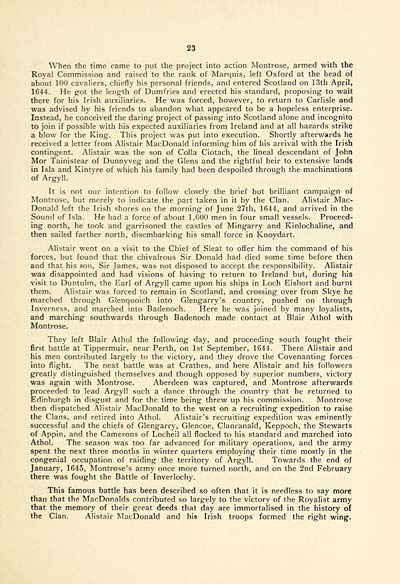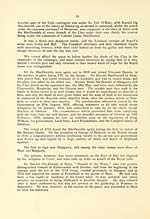Organisations > Clan Donald roll of honour
(27) Page 23
Download files
Complete book:
Individual page:
Thumbnail gallery: Grid view | List view

23
When the time came to put the project into action Montrose, armed with the
Royal Commission and raised to the rank of Marquis, left Oxford at the head of
about 100 cavaliers, chiefly his personal friends, and entered Scotland on 13th April,
1644. He got the length of Dumfries and erected his standard, proposing to wait
there for his Irish auxiliaries. He was forced, however, to return to Carlisle and
was advised by his friends to abandon what appeared to be a hopeless enterprise.
Instead, he conceived the daring project of passing into Scotland alone and incognito
to join if possible with his expected auxiliaries from Ireland and at all hazards strike
a blow for the King. This project was put into execution. Shortly afterwards he
received a letter from Alistair MacDonald informing him of his arrival with the Irish
contingent. Alistair was the son of Colla Ciotach, the lineal descendant of John
Mor Tainistear of Dunnyveg and the Glens and the rightful heir to extensive lands
in Isla and Kintyre of which his family had been despoiled through the machinations
of Argyll.
It is not our intention to follow closely the brief but brilliant campaign of
Montrose, but merely to indicate the part taken in it by the Clan. Alistair Mac-
Donald left the Irish shores on the morning of June 27th, 1644, and arrived in the
Sound of Isla. He had a force of about 1,600 men in four small vessels. Proceed-
ing north, he took and garrisoned the castles of Mingarry and Kinlochaline, and
then sailed farther north, disembarking his small force in Knoydart.
Alistair went on a visit to the Chief of Sleat to offer him the command of his
forces, but found that the chivalrous Sir Donald had died some time before then
and that his son, Sir James, was not disposed to accept the responsibility. Alistair
was disappointed and had visions of having to return to Ireland but, during his
visit to Duntulm, the Earl of Argyll came upon his ships in Loch Eishort and burnt
them. Alistair was forced to remain in Scotland, and crossing over from Skye he
marched through Glenquoich into Glengarry's country, pushed on through
Inverness, and marched into Badenoch. Here he was joined by many loyalists,
and marching southwards through Badenoch made contact at Blair Athol with
Montrose.
They left Blair Athol the following day, and proceeding south fought their
first battle at Tippermuir, near Perth, on 1st September, 1644. There Alistair and
his men contributed largely to the victory, and they drove the Covenanting forces
into flight. The next battle was at Crathes, and here Alistair and his followers
greatly distinguished themselves and though opposed by superior numbers, victory
was again with Montrose. Aberdeen was captured, and Montrose afterwards
proceeded to lead Argyll such a dance through the country that he returned to
Edinburgh in disgust and for the time being threw up his commission. Montrose
then dispatched Alistair MacDonald to the west on a recruiting expedition to raise
the Clans, and retired into Athol. Alistair's recruiting expedition was eminently
successful and the chiefs of Glengarry, Glencoe, Clanranald, Keppoch, the Stewarts
of Appin, and the Camerons of Locheil all flocked to his standard and marched into
Athol. The season was too far advanced for military operations, and the army
spent the next three months in winter quarters employing their time mostly in the
congenial occupation of raiding the territory of Argyll. Towards the end of
January, 1645, Montrose's army once more turned north, and on the 2nd February
there was fought the Battle of Inverlochy.
This famous battle has been described so often that it is needless to say more
than that the MacDonalds contributed so largely to the victory of the Royalist army
that the memory of their great deeds that day are immortalised in the history of
the Clan. Alistair MacDonald and his Irish troops formed the right wing.
When the time came to put the project into action Montrose, armed with the
Royal Commission and raised to the rank of Marquis, left Oxford at the head of
about 100 cavaliers, chiefly his personal friends, and entered Scotland on 13th April,
1644. He got the length of Dumfries and erected his standard, proposing to wait
there for his Irish auxiliaries. He was forced, however, to return to Carlisle and
was advised by his friends to abandon what appeared to be a hopeless enterprise.
Instead, he conceived the daring project of passing into Scotland alone and incognito
to join if possible with his expected auxiliaries from Ireland and at all hazards strike
a blow for the King. This project was put into execution. Shortly afterwards he
received a letter from Alistair MacDonald informing him of his arrival with the Irish
contingent. Alistair was the son of Colla Ciotach, the lineal descendant of John
Mor Tainistear of Dunnyveg and the Glens and the rightful heir to extensive lands
in Isla and Kintyre of which his family had been despoiled through the machinations
of Argyll.
It is not our intention to follow closely the brief but brilliant campaign of
Montrose, but merely to indicate the part taken in it by the Clan. Alistair Mac-
Donald left the Irish shores on the morning of June 27th, 1644, and arrived in the
Sound of Isla. He had a force of about 1,600 men in four small vessels. Proceed-
ing north, he took and garrisoned the castles of Mingarry and Kinlochaline, and
then sailed farther north, disembarking his small force in Knoydart.
Alistair went on a visit to the Chief of Sleat to offer him the command of his
forces, but found that the chivalrous Sir Donald had died some time before then
and that his son, Sir James, was not disposed to accept the responsibility. Alistair
was disappointed and had visions of having to return to Ireland but, during his
visit to Duntulm, the Earl of Argyll came upon his ships in Loch Eishort and burnt
them. Alistair was forced to remain in Scotland, and crossing over from Skye he
marched through Glenquoich into Glengarry's country, pushed on through
Inverness, and marched into Badenoch. Here he was joined by many loyalists,
and marching southwards through Badenoch made contact at Blair Athol with
Montrose.
They left Blair Athol the following day, and proceeding south fought their
first battle at Tippermuir, near Perth, on 1st September, 1644. There Alistair and
his men contributed largely to the victory, and they drove the Covenanting forces
into flight. The next battle was at Crathes, and here Alistair and his followers
greatly distinguished themselves and though opposed by superior numbers, victory
was again with Montrose. Aberdeen was captured, and Montrose afterwards
proceeded to lead Argyll such a dance through the country that he returned to
Edinburgh in disgust and for the time being threw up his commission. Montrose
then dispatched Alistair MacDonald to the west on a recruiting expedition to raise
the Clans, and retired into Athol. Alistair's recruiting expedition was eminently
successful and the chiefs of Glengarry, Glencoe, Clanranald, Keppoch, the Stewarts
of Appin, and the Camerons of Locheil all flocked to his standard and marched into
Athol. The season was too far advanced for military operations, and the army
spent the next three months in winter quarters employing their time mostly in the
congenial occupation of raiding the territory of Argyll. Towards the end of
January, 1645, Montrose's army once more turned north, and on the 2nd February
there was fought the Battle of Inverlochy.
This famous battle has been described so often that it is needless to say more
than that the MacDonalds contributed so largely to the victory of the Royalist army
that the memory of their great deeds that day are immortalised in the history of
the Clan. Alistair MacDonald and his Irish troops formed the right wing.
Set display mode to: Large image | Transcription
Images and transcriptions on this page, including medium image downloads, may be used under the Creative Commons Attribution 4.0 International Licence unless otherwise stated. ![]()
| Rolls of honour > Organisations > Clan Donald roll of honour > (27) Page 23 |
|---|
| Permanent URL | https://digital.nls.uk/100225096 |
|---|---|
| Description | Listed alphabetically. |
|---|

